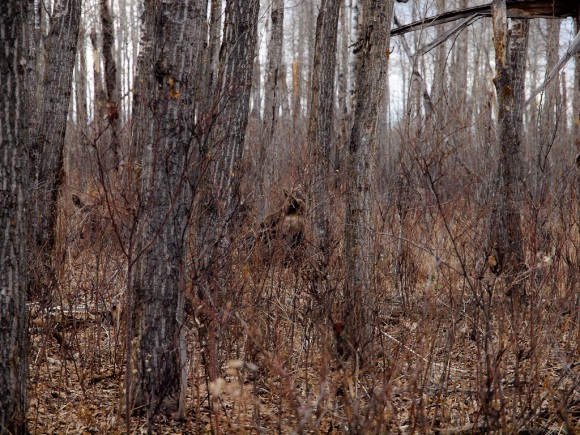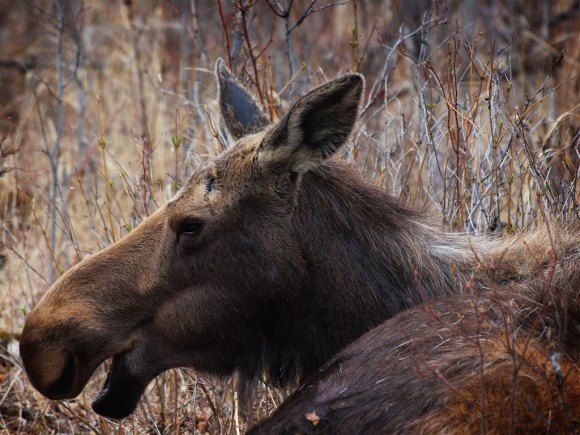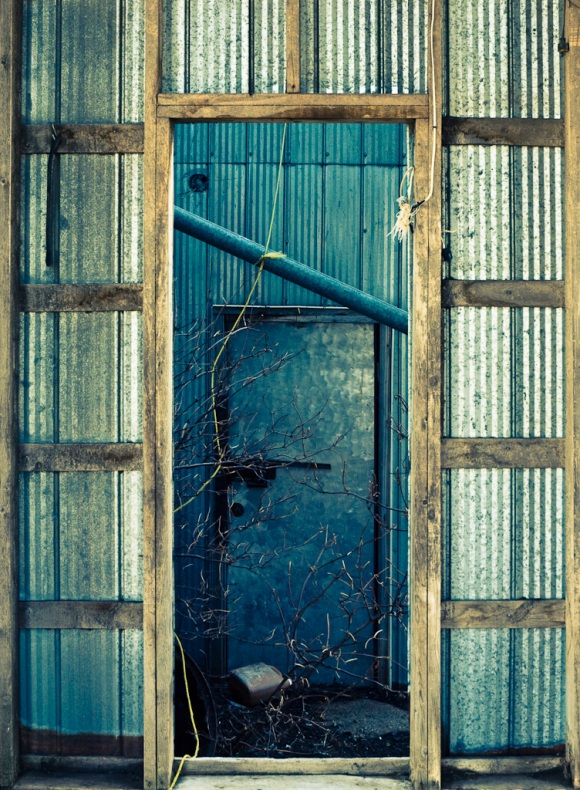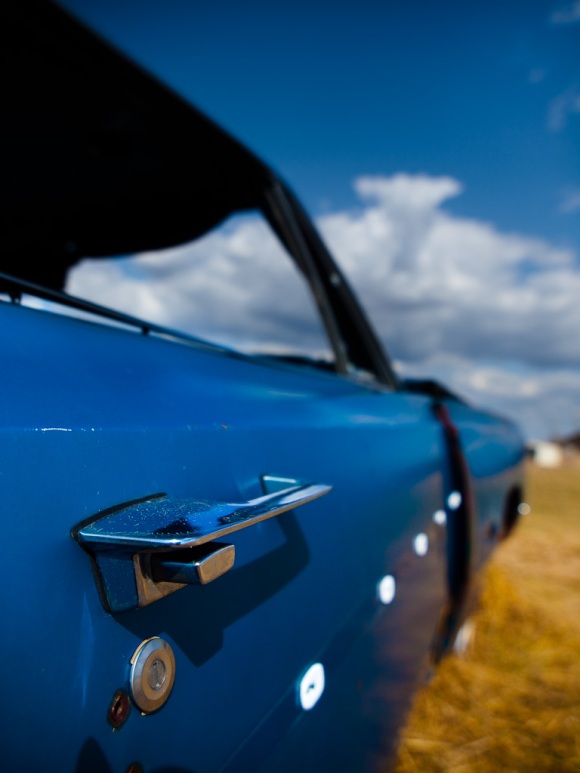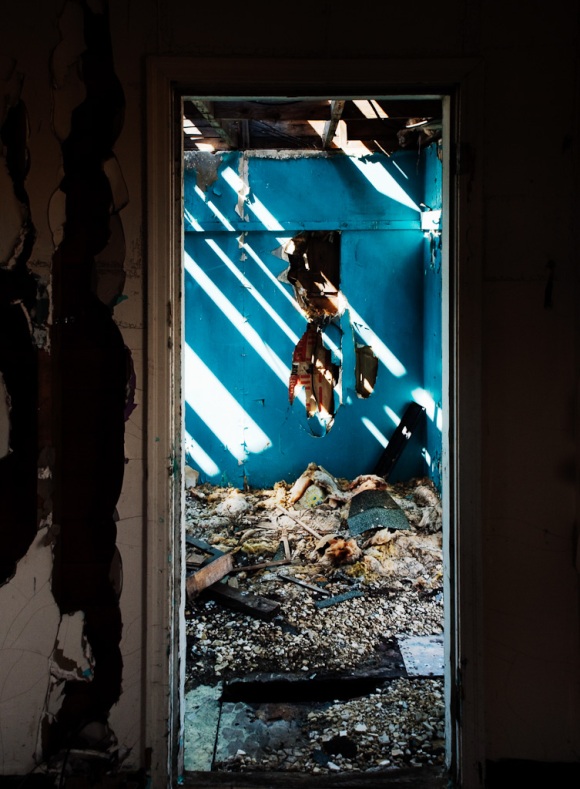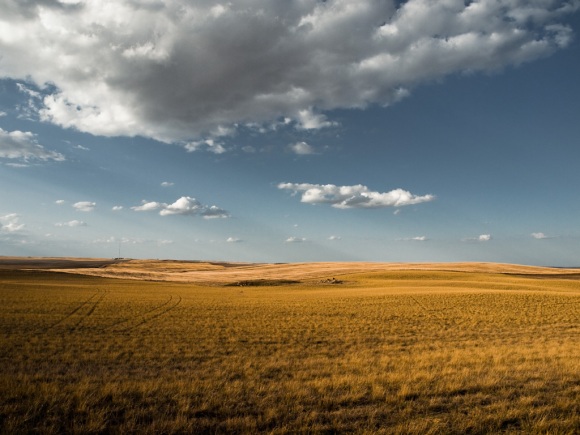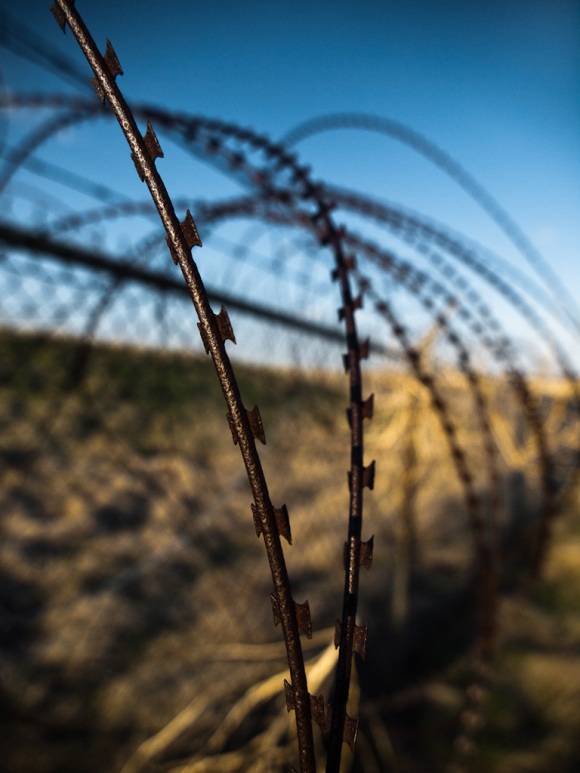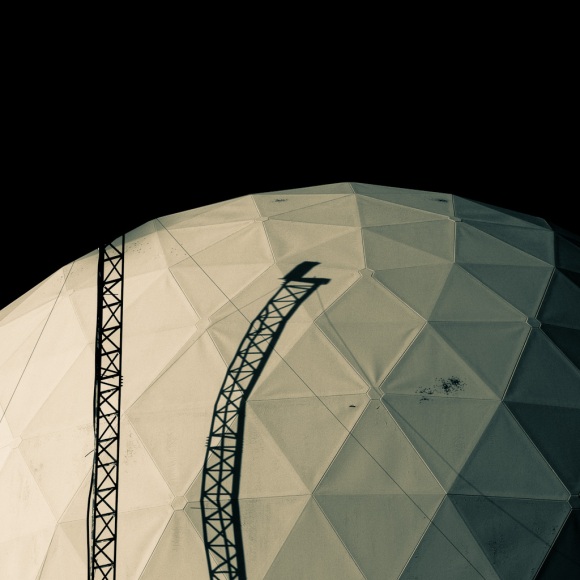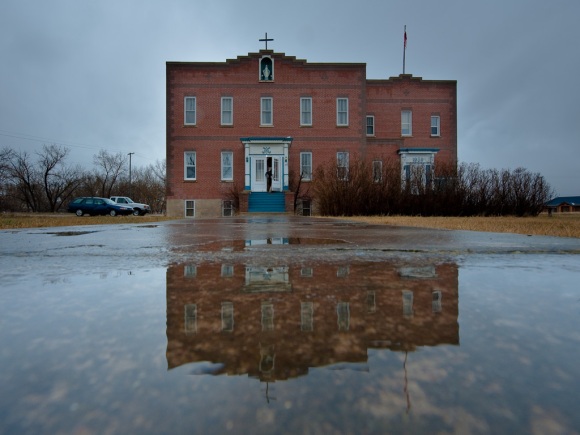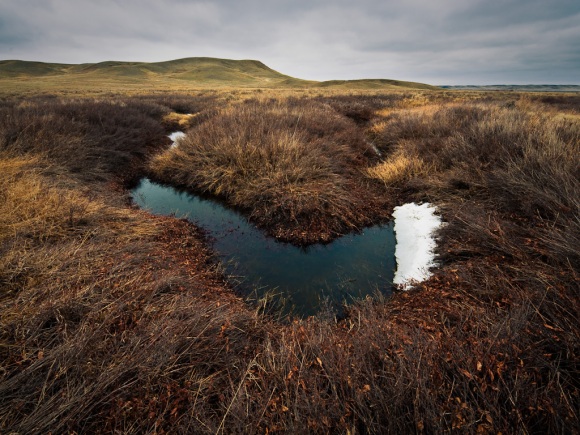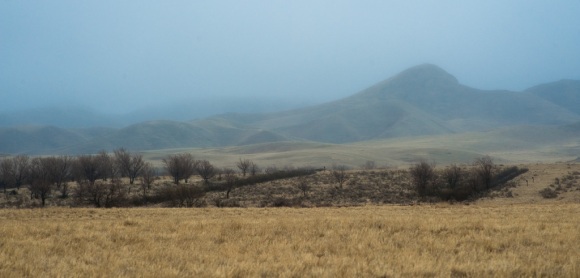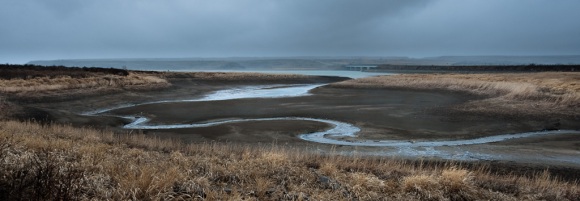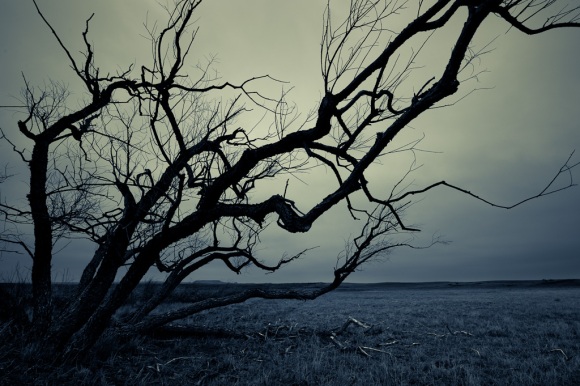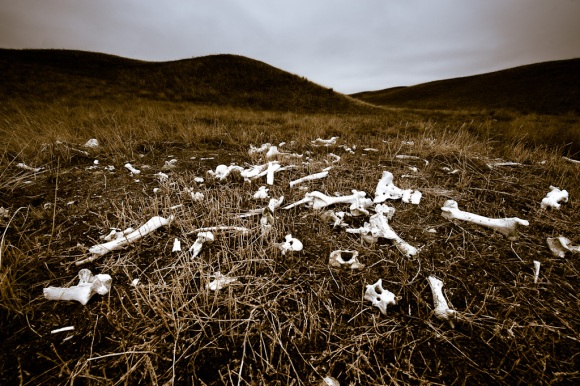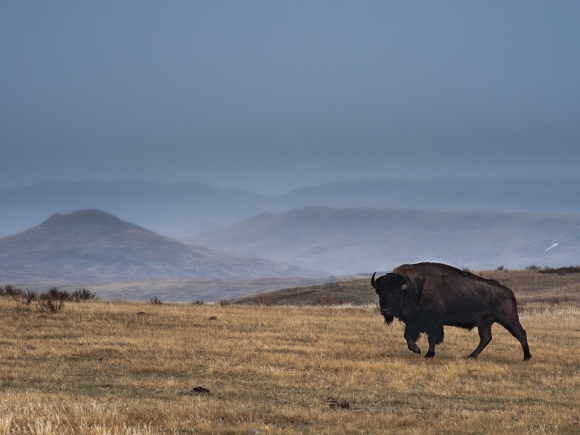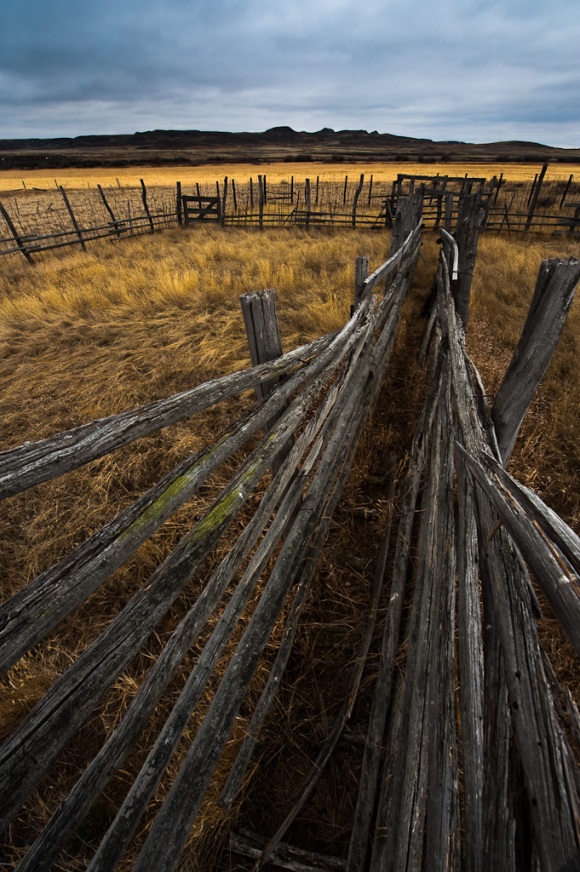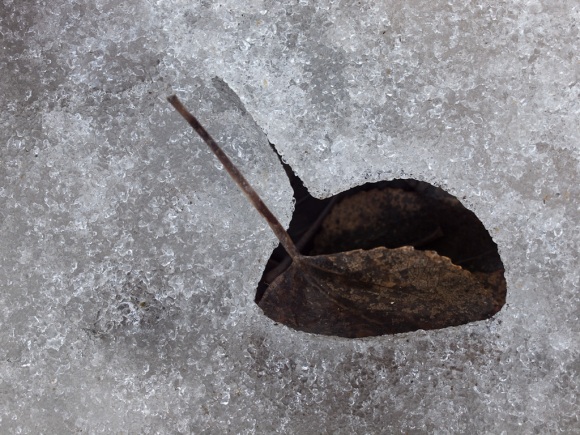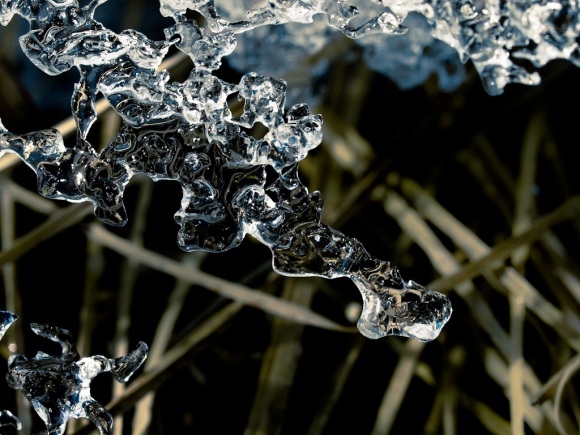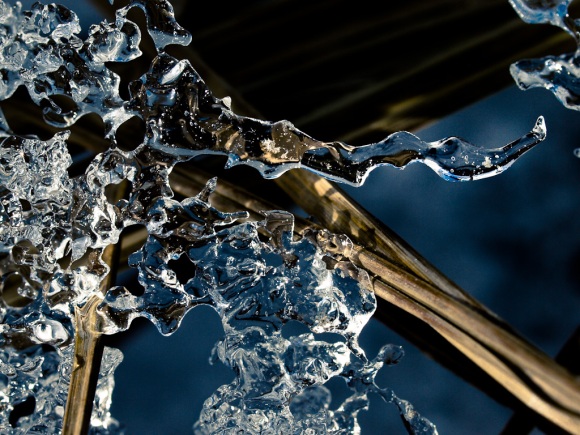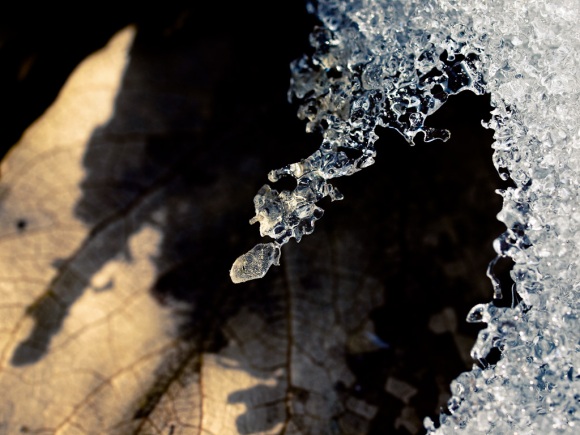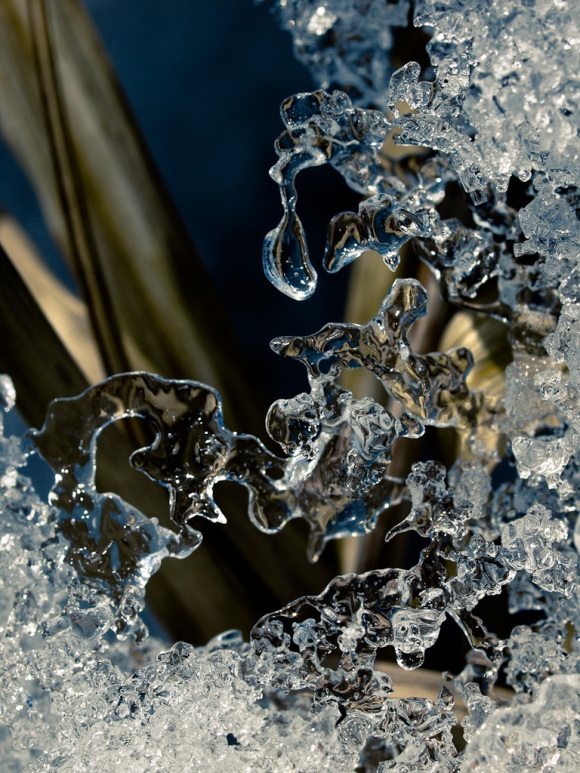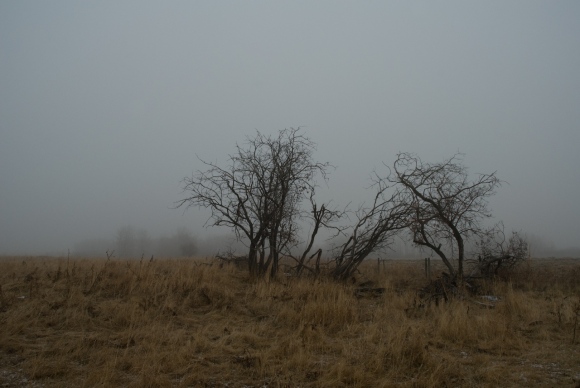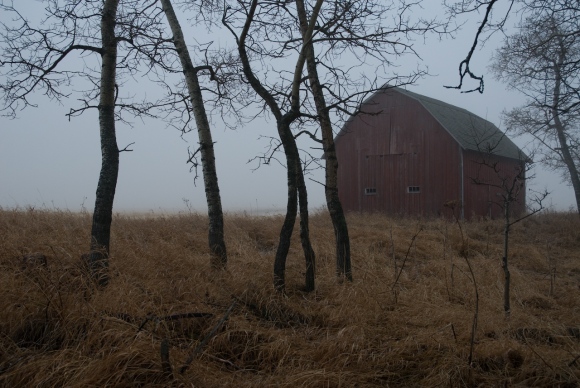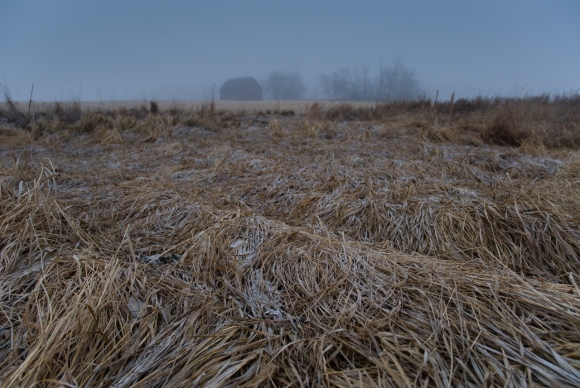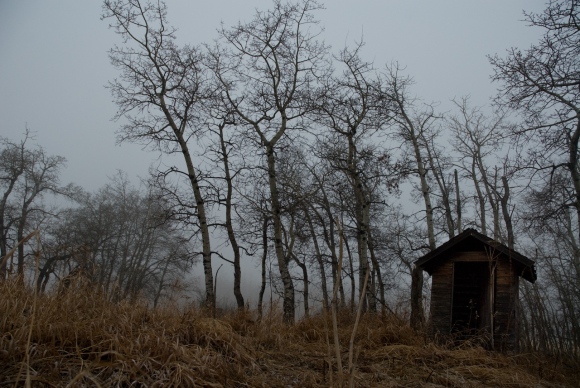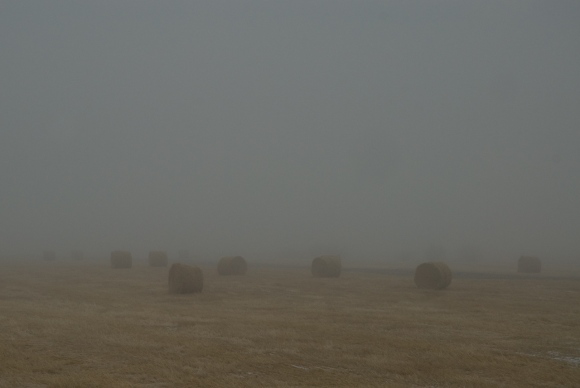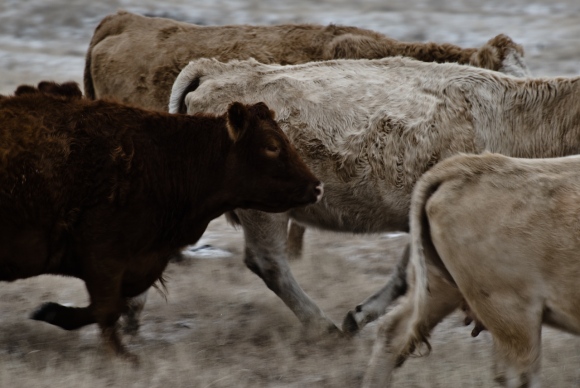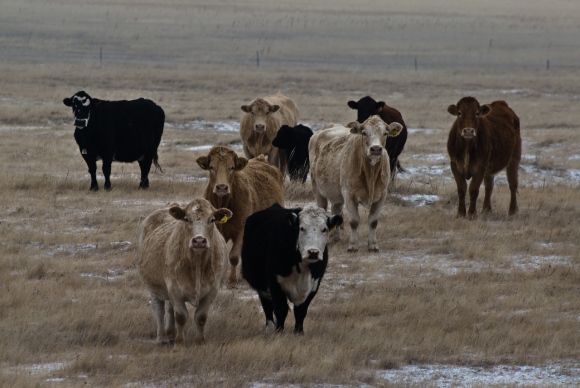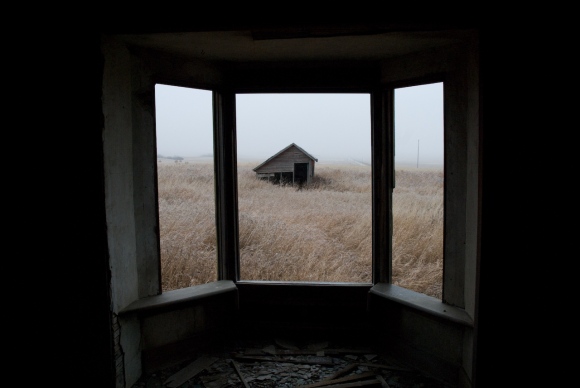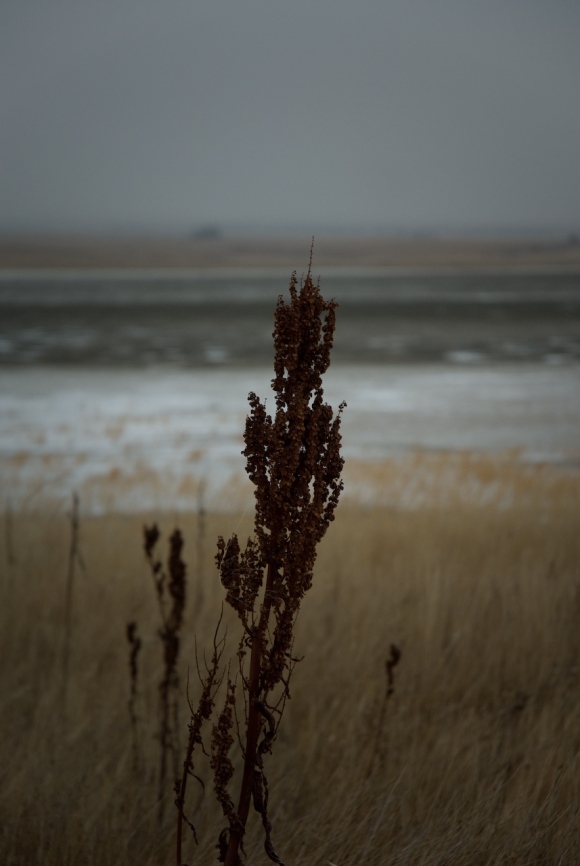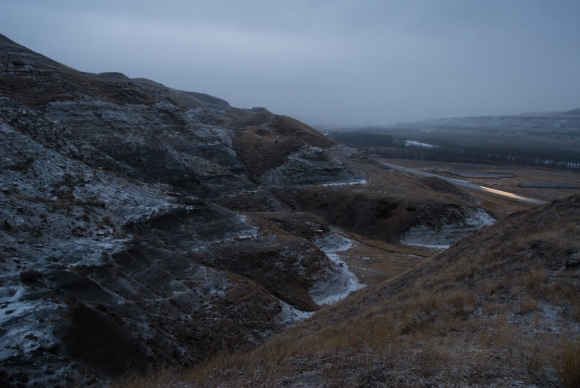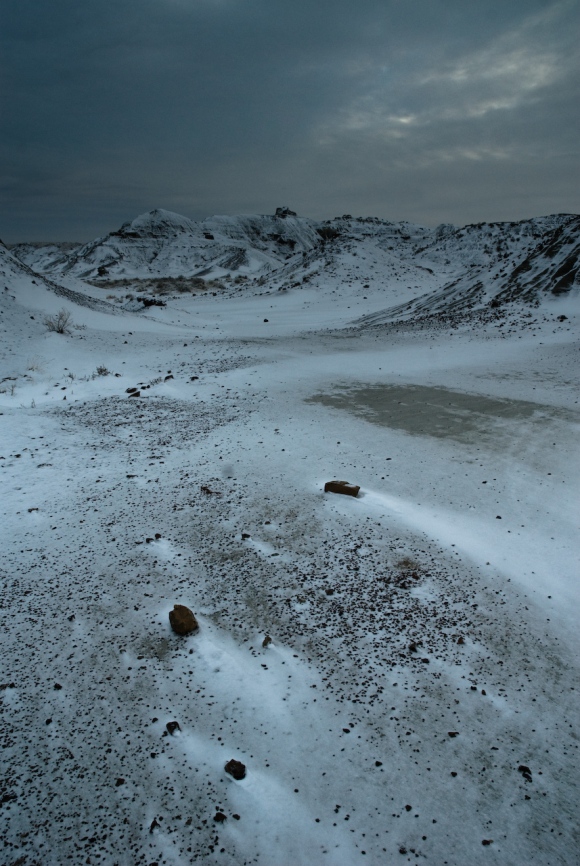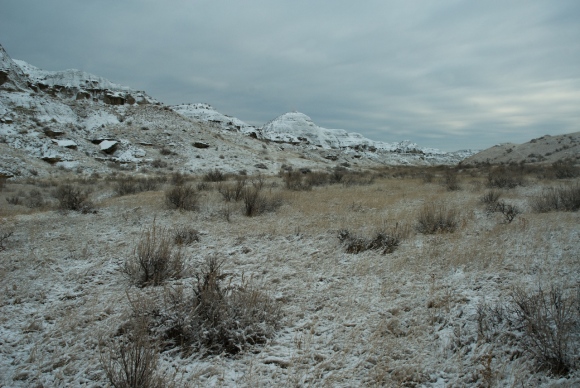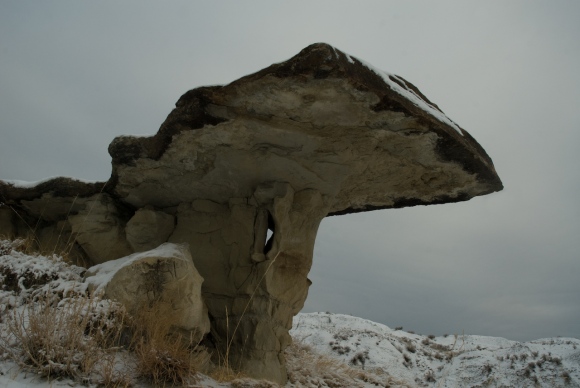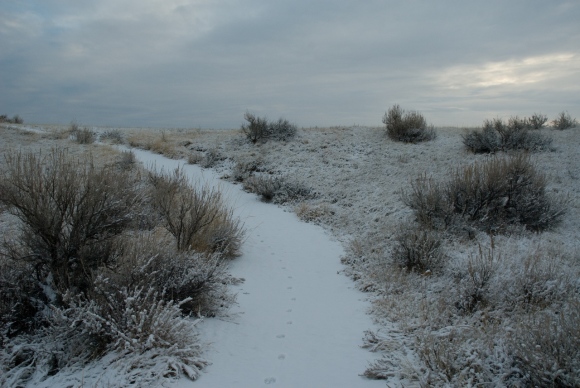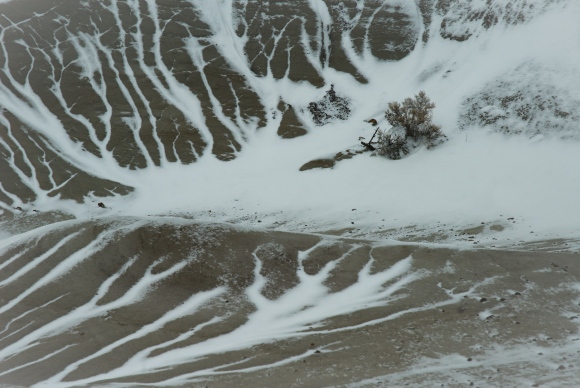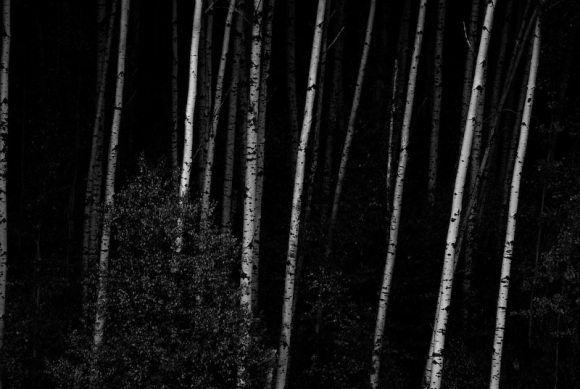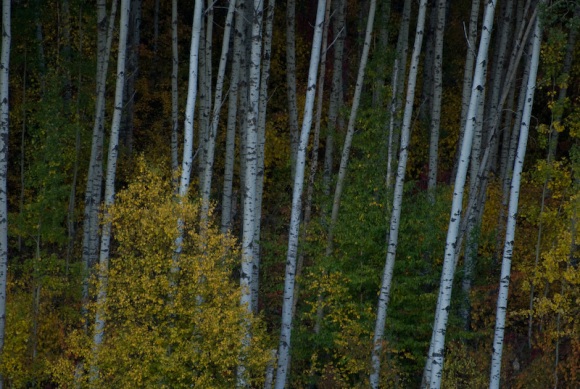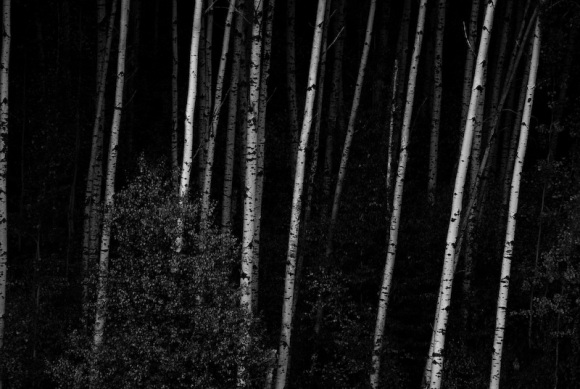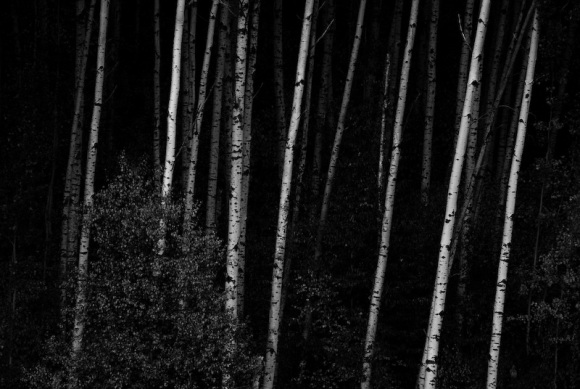Elk Island is packed with wildlife. Most of it is pretty skittish. The whitetail deer bound off before you notice them so all you see is a their tail waving at you. The wood buffalo keep a wary eye on you and stay far away (unless you’re driving of course). The moose though are a different story. The moose are calm, cool, and collected. They’re like “S’up? I’m busy eating. You want me to pose? Sure. How ’bout I turn this way? Mmmm, tasty twigs on this side.”
Disappearing
Today’s post is dedicated to the life on the prairies: pictures of an old seed cleaning plant, the interior of a wooden grain elevator, some gears from a threshing machine, an abandoned town, and an old radar dome which is a relic from the cold war.
A road trip with Jason is a departure from my normal weekend hike, and brings with it photos I wouldn’t otherwise have taken. It was a great trip through some of my favorite landscapes (eastern Alberta is much more hilly than one would think). But rather than exploring the landscape, we went to all the places between the landscapes – the ghost towns. I’d never been inside an elevator before, not to mention an abandoned radar station. Some people think I’m crazy for hiking alone, but exploring structurally questionable buildings seems much more dangerous to me. It was pretty fascinating though.
Seed cleaning plant:
Threshing machine gears:
An old car on the prairies:
House: destroyed but still standing
Grain elevator interior:
Hah, I snuck in a landscape anyway.
Rusty razor wire – how friendly
The radar dome at Alsask:
New Thoughts on Old Photos
A couple days ago I was cleaning up my library of photos and came across a couple photos that I haven’t seen in a long time. For some reason I had originally rated them quite low and they were lost in the depths of my computer until I stumbled on them again today.
The first is from my Yellowstone trip of 2007. There seems to be some sort of interesting complimentary / reflective thing going on here. The yellow reeds are almost exactly mirroring the trees and mountain, and the water contrasts the sky – the tones are almost reversed while the colors are complimentary. Anyway, it caught my eye, and after staring at it for a while I do believe I like it.
no images were found
The second is just from last year in Jasper, but it got lost in the shuffle of more bold and colorful pictures (or maybe dark and brooding, I occasionally gravitate towards that). This one has a more quiet feel but still has a lot going on.
no images were found
A Good and Disasterous Journey
Grasslands National Park is a little known park in southern Saskatchewan. It sounds dull, flat, and lifeless, and that couldn’t be further from the truth. In fact, in the last hour of driving before we got to the park, we must have seen 50 deer. Unfortunately the 51st decided to sprint directly at our car at a break neck speed – literally. We were a little shaken, our passenger side door was quite dented, and the deer was dead. There was really nothing to do but carry on to the hotel.
Well, not really a hotel – more of a hostel / bed and breakfast / very interesting place to stay. We stayed at the convent. It’s an old school that has been renovated into a “country inn” which has 9 (I believe) guest rooms, a library, a study, a chapel, and a dining room. None of the guest rooms has a bathroom, but they all have sinks and there are 3 bathrooms across 2 floors. The outside looks like an old two story schoolhouse, and the inside still has all the wood floors and cabinets. Our room was very bright and airy, and at night when we had the whole building to ourselves, got a little spooky. But we slept very well on comfortable beds, ate wonderful food prepared by our hosts, and thoroughly enjoyed our time there.
I am a nature photographer, and as a nature photographer, I often say that the worst weather is the best weather for shooting. I knew it was going to rain the weekend we were there, and I was pretty excited about that. The first day it didn’t rain. We didn’t see the sun. There was no sunrise and no sunset. The clouds were a uniform dull gray. This was slightly disappointing, but nevertheless, I ventured forth and spent my day photographing the park. In fact, I really enjoyed it. I never saw one person the whole day, but had plenty of company in the form of mule deer, whitetail deer, prairie dogs, bison, coyotes, and a plethora of birds. One of my friends generously lent me his Nikon D700 and some amazing lenses for our trip, so I enjoyed using some very capable gear to capture the amazing surroundings and the dull light.
The next day it rained. Normally I like rain, but this slushy rain made the park inaccessible. The roads were too muddy, and we almost got stuck trying to get into the park. Luckily, southern Saskatchewan has other attractions for the foiled photographer. We went to a nearby ghost town, and took pictures of old abandoned buildings.
We got off to a bit of a late start for the drive home. We got chatting with our hosts, Robert and Mette, which made it hard to leave quickly, but the promised storm was blowing in and we wanted to be on our way before it got bad. The drive home began with a very nice photo ingredient – fog. There was a little rain, a little snow, but mostly it was foggy. This precipitated a surprisingly beautiful stop in Saskatchewan Landing Provincial Park, which I now really want to go back to. Unfortunately we couldn’t stay long, so after a bit of exploring we headed back to Edmonton. Little did we know we were heading into a blizzard.
I don’t have pictures of this part. I wanted to get them, but there was 10 inches of slushy wet snow everywhere except the tracks we were driving in, so I couldn’t pull off to the side of the road. I almost got stuck going in the gas station parking lot trying to get gas. It was a stressful drive to say the least. At last we got through the storm into sunny Alberta, and after a few more short stops we were having supper in Camrose. With an hour left to drive, we were reminiscing about the amazing success we’d been able to pull out of this disaster known as our working vacation. I had just said something to the effect of “If another deer jumps out in front of us…” while shaking my fist, when a moose walked into the road. Leisurely. I came to a rolling stop about four feet from her, before she realized that maybe moving would be an good idea. Well, at least it finally settled the debate we’d been having about stopping distance – it turns out you can stop in the distance illuminated by high beams.
Spring Storm
Last week we had our first thunderstorm of the season! Despite my aversion to being struck by lightning I can’t resist a good storm. So I headed out to Hasse Lake to take a few photos:
Lying and Cheating
If you’re not editing your photos, you’re lazy or misguided. There – I said it.
I’m tired of people claiming “purity of image” or “truth” in an unedited photo. The moment you take a picture you are interpreting the scene – if you’re trying for truth, you’re a long way off. You choose the framing, you choose the lighting (yes even in natural light), you choose the angle, and you choose which pictures you show to people. If you’re a photographer, you are already interpreting – just possibly not enough to make any point.
If you don’t think you are interpreting a scene, I would like to hear from you. What are you doing? You are already limiting my view to a tiny window, and taking away all my other senses.
If you are trying to interpret a scene, why would you stop editing the moment it leaves your camera? You’re missing out on an opportunity to share your perspective. You could get rid of distracting elements that take away from your idea. You could add distracting elements if obfuscation is your goal. You think you made a perfect image that perfectly conveys your perspective? Possible, but chances are it could be clear, more compelling, and possibly more truthful – and you’re too lazy to do it. It is not cheating to use a different medium in a work of art.
Whether the point you are making is representing something truthful or not is a completely separate issue, and a hard one for many photographers. It depends a lot on the kind of photography you do. This has been a very hard question for me to answer in the past but its getting easier: I’m leaning more and more towards this not mattering. I am not seeking to represent truth. I’m seeking to represent beauty, loneliness, verdant life, desolation, quietness, grandeur – the list goes on and on. I’m not sure truth is something even to be considered in art photography. I’m more interested in the way the eye moves across a photo, the emotional responses it evokes, and the interplay of light and subject. I’m even occasionally interested in an analytical response.
If you dislike editing, fair enough. There are things you can do in the camera to create great photos, and many great photographers have done little post processing (although this is more rare than you might think). But to take an image that almost says something, and to not give it that final push is criminal. I’ve seen too many almost good photos in my life. Why would putting work into a piece of art be looked down upon? I can’t understand this.
So please edit your photos. I would like to see your perspective on life and truth. Some people will hate you for it, but I will be eternally grateful.
ps. For the record – I don’t do much editing on my photos, but I think I’m going to start to do more. I’m trying not to be so lazy myself.
Spring Ice Series
Alternatives
For the past couple years I’ve been doing all my photography, web development, and everything else on a Macbook Pro. It’s a nice computer. Only occasionally locks up. Does everything pretty seamlessly, almost never gets in the way. There seems to be a lot less maintenance then when I had a windows computer. Overall, I enjoy it quite a bit, but…
Every once in a while I catch myself looking wistfully at shiny new motherboards, processors, graphics cards and cases. I remember assembling them all into a modular beauty. I can picture a black screen with a command prompt and a blinking cursor. Customizing a kernel module was a frustrating and wonderful thing at the same time. Sometimes I’m really tempted to go back to linux.
So it makes sense for a programmer to use linux, maybe even a web developer, but a professional photographer? Yeah, I dismissed it as ridiculous for a while. But one day I stumbled across Bibble. Hmmm, a raw developer that works on linux. Sure there’s always been dcraw, but for managing a catalog of thousands of raw files, that really is not going to work. But Bibble is interesting. I tried a preview of version 5 on my mac, and honestly I liked the results a bit better than out of Lightroom. But here’s the problem: version 4 doesn’t support my camera, and version 5 was supposed to be out about 2 years ago – and it’s still not done. That makes me wonder about future support.
So I’m still looking wistfully at those computer parts and dreaming of linux. Don’t ask me why – I’m not missing anything on my Mac. Maybe I’m a bit sentimental.
Winter Roadtrip in the Prairies
Prairies are incredible. They’re more subtle than most landscapes, but they convey such a sense of freedom that they keep drawing me back. Last weekend I went on a roadtrip to south eastern Alberta. There were a number of places I was interested in seeing. Among them were Dinosaur Provincial Park, Red Rock Coulee, some sand dunes south of Wainwright, and a bunch of dried out salt lakes. Due to some unforseen vehicle trouble, I didn’t get to them all, but it was an amazing roadtrip none the less.
I took the scenic route on the way down from Edmonton. In this case that means almost random highways, secondary roads, and a fair number of gravel roads thrown in. The gravel roads are where you get to see the interesting stuff. You’re going slow enough that you can stop if you see something interesting and no one will mind if you’re stopped on the side of the road. In fact, probably no one will drive by. The day I drove down the weather was pretty bad. It was fog and freezing rain for much of the way, and gravel is less slippery than highways anyway in this case.
What people generally consider bad weather makes for great pictures though, so I stopped at an old farm to take some pictures.
I was heading roughly in the direction of Drumheller and Dinosaur Provincial Park, and I had been looking around google maps for interesting places to stop on the way down. Sullivan Lake, east of Endiang, looked quite interesting, so, not really knowing the area, I drove as close as I could along one gravel road. The landscape was pretty interesting – it looked like the lakebed was pretty much dry, but I never got close enough to know for sure. There were lots of interesting hills surrounding the lake, and cattle were grazing in the area. I got out and hiked around for a bit. The cattle were interested in me, but seemed pretty scared of me. I mooed at them for a while, and they got quite curious. They slowly came closer and closer. When they started to encircle me, I got a little nervous, and headed back towards the car. Even if cows aren’t mean (and some of them are), stampeding cattle is just a bad thing all around, and something I definitely wanted to avoid being in the middle of.
Next I headed down towards Chain Lakes, which are a series of smaller alkali lakes.
Being December in Canada, it gets dark pretty early, and if I wanted to still see the Red Deer River valley I had to get going. I headed down towards Drumheller, stopped there for gas, and kept going down highway 10, which winds its way down the valley. This is a beautiful drive, and highly recommended. It continues as the 570, and eventually comes up out of the valley at Dorothy, a little hamlet that still has a standing wooden grain elevator. It looks pretty rickety though, and I don’t know how much longer it will be standing.
Dinosaur Provincial Park is actually quite a bit downstream from Drumheller. For some reason I thought they were pretty close, but this is not exactly the case. From the 570 I headed down the 36 to Brooks where I had supper and filled up. This was fairly late on a Sunday night, so everything in Duchess was closed. By this time I needed to start looking for a good place to sleep. Picking a place to sleep in a car is harder than it might sound. Theoretically you could park anywhere and sleep. However, there are a number of conditions that make it a little more complicated. First of all, you want to make sure you’re not blocking any driveway that someone is going to need to use at 5 in the morning. Second, you want a place to park that is not in a parking lot where people are either going to be driving or walking by. I don’t have tinted windows in my car, and I don’t want to either weird people out (I think sleeping in a car is generally considered to be weird) or be disturbed during the night. Despite precautions against these, its pretty much impossible to find a perfect place. Often I’ve had hunters or snowplows driving by early in the morning (in the case of snowplows they’re pretty loud and can give you a bit of a scare first thing in the morning). So around 8 I started looking for a good place. I also wanted it to be pretty close to the park, so I could photograph with the early morning light. Complicating things was a heavy snowfall warning and almost bald tires on my car. I found a driveway into a farmer’s field off of a gravel road that wasn’t to close to any farmhouse that did pretty well. I got a good 7 hours of sleep wrapped in a couple of sleeping bags. It went down to -13 C, so I woke up in the morning fairly cold. I started the car to get some heat going, and the car was rattling quite a bit. This was a little worrysome, as I was miles from any town and 6 hours from home. Interrupting my worries, the car lurched a bit. Strange, I was in neutral. Well, I tried putting the clutch in, and miraculously the rattling stopped. Uh oh, that means it’s my transmission. Well, I was about a 10 minute drive from the park, so that didn’t make much of a difference to whether I could get home or not. So I drove out to Dinosaur Provincial Park, and that went quite well. The car seemed to work fine. Maybe if I just avoided letting the clutch out while in neutral I’d be ok. I got to Dinosaur Provincial Park, and I was the only person there. It was first thing Monday morning, with fresh snow on the ground. Simply beautiful. I hiked around for quite a few hours, thoroughly enjoying myself.
OK, that’s probably enough pictures. Despite quite a bit of cloud cover, you can see it was amazing. There were cat tracks everywhere, and I’m curious what kind of cats frequent the park. They didn’t look big enough to be a cougar or anything – just slightly larger than housecat tracks. There were also rabbit, and many small rodent tracks. Fresh snow is cool. I never saw any animals though, despite all the tracks.
After getting back to the car, I decided to cut my roadtrip short. I had a couple energy bars for lunch, finished the can of cold chili I had for breakfast, and started the car. Good so far. I was really sorry to miss Red Rock Coulee, but really happy with what I did get to see. I drove north, along the icy highway 36, and all was well. Suddenly the engine revved, and the car started slowing down. That’s not good. I tried fourth gear. Ok, good. That was still catching. Back into fifth. It went in easily enough, but there’s nothing there. I had no fifth gear. Well, back into fourth gear.
I drove the whole way home in fourth gear at around 100km/hour. Yeah, that’s what the speed limit is, but everyone else was going so much faster and I held up quite a bit of traffic. I ended up taking a lot of gravel on the way home to avoid fast traffic, which ended up being good because the highways were icy and it was snowing too.
I got home, ate a bunch of warm food, had a warm shower, and fealt like going out on another road trip.
First in a Series of Self-Critiques
This post is the first in a series of photo critiques I plan on doing with my own pictures. My goals for this are to improve my photography by conscious analysis and to give other photographers ideas for creating better images. I’m sure I’ve missed a lot in my analysis, and I welcome any questions, comments, corrections or additions.
Here is a recent picture of a poplar forest after sunset at Chickakoo Lake. It was taken at a focal length of 300mm at f5.6. The shutter speed was only 1/80 of a second, so I used a tripod and mirror lockup to get a sharp picture. This is the original with only some white balance corrections applied to the raw file:
What works:
My aim is for the photo to be simple and striking, evoking a sense of quiet unknown. The main, almost only, element in the photo is the repeating tree trunks disappearing into the forest. The narrow field of view from the 300mm lens helps crop out distracting elements: the sky, the treetops, the underbrush.
I kept the leafy tree in the bottom left. It does break up the repeating tree trunks, but works to stop some of the strongest lines in the image from dropping off the bottom edge. Instead the viewer’s eye gets briefly trapped in the subtle detail of the leaves before being snapped back to the high contrast tree trunks.
1. Compression – I used a 300mm telephoto lens. One of the effects of a telephoto lens is to compress the foreground and background into a single plane. There is no vanishing point: parallel lines do not converge. This makes the picture look flat – things that are actually separated by a lot of space appear to be right next to each other.
2. Depth – The evening light highlights the first few trunks of the poplar trees. These are very high contrast and grab the eye quickly, even if you just glance at the photo. Deeper into the forest, the trunks are darker, but still visible. This adds a subtlety and depth that can draw the eye in and hold it longer. There’s a sense of mystery as the forest is only partially revealed.
I find it interesting to play with depth through color and contrast in an image which has very little depth from foreshortening. Extreme wide angle is very popular for landscape photographers these days, and it often works very well, but good landscape photos are also possible at telephoto focal lengths and are a little more unusual.
What doesn’t:
I don’t particularly like the original colors in this image. The soft yellows, greens, and pinks take away from the high contrast, mysterious effect. They could be useful for a different goal, but I really like the dark brooding forest of the edited version. So I played with the curves a little bit to add contrast and converted to black and white. I can’t quite decide if the contrast is too strong now. Are there too few details left in the background?
On the left edge of the image is a dimly lit tree trunk beside a large dark area. I find that tree distracting. I may crop out the tree to give the image a little more balance, but it’s too bad because I really like that large dark void.
